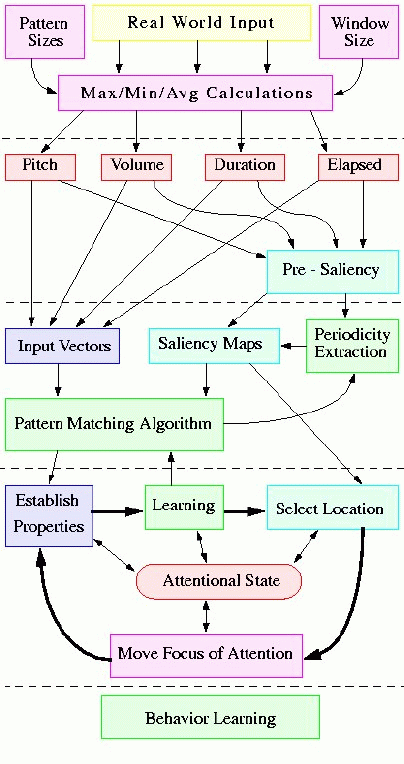Mood - Report
7. Attentional Loop
 The attentional loop is composed of four types of procedures, called
serially always in the same order, establishing properties at specific
locations, learning patterns, selecting locations, and moving to new
locations. A behavior is specified by the commands that are going to
be called from each family.
The attentional loop is composed of four types of procedures, called
serially always in the same order, establishing properties at specific
locations, learning patterns, selecting locations, and moving to new
locations. A behavior is specified by the commands that are going to
be called from each family.
Establish Properties
This is the largest of the procedure categories. It works on the
specified focus of attention to establish local properties.
- Establish relations between properties
-
- High duration followed by rise in volume then silence/applauding
- This could be hard coded in our brain. When we hear ssssssssssSSSSSSSSSHHH-BOOM!
- Determine movement type at current location
- A movement could be either sad, or angry, or romantic - determine based on low-level + patterns
Learning
The procedures in this category are responsible for the learning that
gets done in the system. Different types of learning are possible, and
they're basically controlling the pattern matching code into doing
useful things.
- Learn patterns of length i-j ending at current note
- Records the patterns either learning them as new entries
in the pattern table or changing old patterns to be able to
match the new input.
- Do not learn anything.
- If the input is not salient, or not interesting, or simply
that we're sure that we're already matching something well known,
we can simply not record anything.
- Learn pattern of patterns.
- One can simply abstract at a higher level and learn patterns
of patterns instead of patterns of notes. Useful for more complex
behaviors.
Select Location
There are different ways of selecting a location, and different
criteria to base this selection upon. A location is either a note
or a window size, or a voice to listen to.
- Select most salient overall
- One can simply pay attention to the note that is the most
salient in the current window, or to the voice that's most salient
- Select most salient on a particular feature
- The feature can be volume, duration, pitch or their derivatives
- Select based on pattern
- From the pattern matching code, we can select the location
that matches optimally the current pattern, or a particular pattern
we are interested in
- Select on periodicity
- Location either where the next salient note should appear,
or where a periodic pattern should start appear again.
Move Focus of Attention
As mentioned above, there are more than one type of locations to move
the focus of attention to, and there are more than one ways to move
the focus of attention there.
- Move to selected voice
- Changes the current voice, where patterns are recorded from
- Move to selected time
- Changes the current time to be something different than the next time
- Move to selected window size
- Changes the window size based on which saliencies are calculated
- Move to selected pattern
- Changes the current pattern to which we're matching
- Move completely or partially
- Finally, one can move there completely or still pay attention to many other things
 The attentional loop is composed of four types of procedures, called
serially always in the same order, establishing properties at specific
locations, learning patterns, selecting locations, and moving to new
locations. A behavior is specified by the commands that are going to
be called from each family.
The attentional loop is composed of four types of procedures, called
serially always in the same order, establishing properties at specific
locations, learning patterns, selecting locations, and moving to new
locations. A behavior is specified by the commands that are going to
be called from each family.